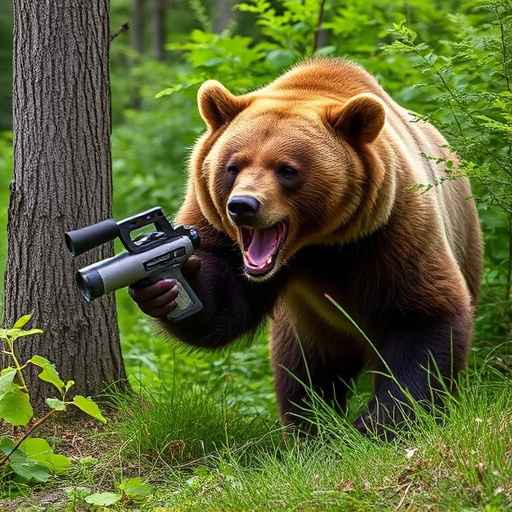Understanding bear behavior is key to preventing attacks. Recognize defensive body language and take precautions like using bear pepper spray (adhering to TSA restrictions), staying in groups, making noise while hiking, and not approaching bears. Pepper spray offers a window of escape but isn't foolproof due to distance, wind, and bear behavior; comply with global regulations for carry-on items to ensure its availability. Alternative strategies include making noise during hikes and being mindful of liquid container restrictions when packing for potential bear encounters.
In wilderness survival scenarios, understanding bear behavior is key to avoiding attacks. Human-bear interactions are complex, and knowledge can significantly enhance safety. This article explores strategies to mitigate risks, focusing on bear pepper spray as a popular choice. We delve into its effectiveness against aggressive bears and discuss TSA restrictions on travel, ensuring compliance without compromising safety. Additionally, alternative methods for bear deterrence beyond spray are presented, offering a comprehensive guide to navigating these encounters.
- Understanding Bear Behavior and Their Attitudes Towards Humans
- The Role of Pepper Spray in Bear Attack Protection: Effectiveness and Considerations
- TSA Restrictions on Bear Pepper Spray: What You Need to Know for Travel
- Alternative Strategies for Bear Safety: Beyond Pepper Spray
Understanding Bear Behavior and Their Attitudes Towards Humans
Understanding bear behavior is key to preventing and escaping attacks. Bears, especially grizzlies, are often misunderstood as aggressive creatures constantly seeking humans for food. However, their interactions with people are generally defensive responses to perceived threats or unexpected encounters. These animals have a natural wariness of humans, but conflicts arise when individuals get too close to bear habitats or disturb their cubs.
When it comes to bears and humans, knowledge is power. Recognizing their body language can provide crucial clues. Bears may huff, swat, or charge as warnings before attacking if they feel threatened. Proper precautions, like carrying bear pepper spray (which falls under TSA restrictions for carry-on luggage), staying in groups, making noise while hiking, and not approaching bears, significantly reduce the risk of encounters that could escalate into attacks.
The Role of Pepper Spray in Bear Attack Protection: Effectiveness and Considerations
Pepper spray has emerged as a popular and effective self-defense tool for wilderness survival scenarios, particularly against bear attacks. Its ability to temporarily incapacitate an attacker by irritating the eyes and respiratory system makes it a valuable asset in remote areas where bears roam. However, understanding its effectiveness and limitations is crucial before venturing into bear country.
When used correctly, bear pepper spray can offer a critical window of opportunity for escape or summoning help. It’s important to note that while pepper spray may deter an attack, it doesn’t guarantee complete protection. Factors like the distance between you and the bear, wind direction, and the bear’s behavior play significant roles in its success. Moreover, travelers should be aware of TSA restrictions on carrying pepper spray, especially for air travel, as regulations vary globally. Proper usage techniques and knowledge of local guidelines can ensure that this tool is ready when needed.
TSA Restrictions on Bear Pepper Spray: What You Need to Know for Travel
When preparing for wilderness survival or even planning a trip to bear-inhabited areas, it’s crucial to understand the TSA restrictions on bear pepper spray. The Transportation Security Administration (TSA) has specific guidelines regarding the carriage of self-defense tools like bear pepper spray, ensuring passenger safety during air travel. These regulations are in place to maintain order and prevent unauthorized items from boarding aircraft.
Bear pepper spray is a popular choice for outdoor enthusiasts due to its effectiveness in deterring bears. However, travelers must adhere to TSA rules, which limit the size and quantity of these aerosol cans that can be carried on board flights. Typically, only containers of 3.4 ounces (100 ml) or less are permitted, and they must fit comfortably in a carry-on bag. It’s essential to check with both your airline and the TSA before packing bear pepper spray to ensure compliance with current restrictions, ensuring you have a viable option for protecting yourself during your outdoor adventures.
Alternative Strategies for Bear Safety: Beyond Pepper Spray
Many outdoor enthusiasts and wilderness travelers rely on pepper spray as their primary defense against bear attacks. While it’s an effective deterrent, there are alternative strategies to enhance your safety in bear country. Beyond carrying bear pepper spray, consider these additional measures to increase your odds of staying safe during encounters with these majestic animals.
One approach is to make noise while hiking or camping in bear-inhabited areas. Loud voices, singing, or playing music can help deter bears from approaching unexpectedly. Additionally, using bell rings on clothing or gear can create a constant, subtle reminder of your presence. Remember, bears typically avoid humans, and making yourself heard can prevent them from seeing you as a potential prey item. Keep in mind that the TSA has restrictions on liquid containers, including those for bear pepper spray, so plan accordingly when packing for trips involving potential bear encounters.
While bear pepper spray is a popular and effective tool for wilderness survival, it’s crucial to understand its limitations and the evolving TSA restrictions on carrying such items. Beyond chemical deterrents, exploring alternative strategies like making noise, avoiding unpredictable terrain, and knowing local bear behavior can significantly enhance your safety in bear country. Combining these methods offers the best protection when facing potential bear attacks, ensuring a safer outdoor experience for everyone.
